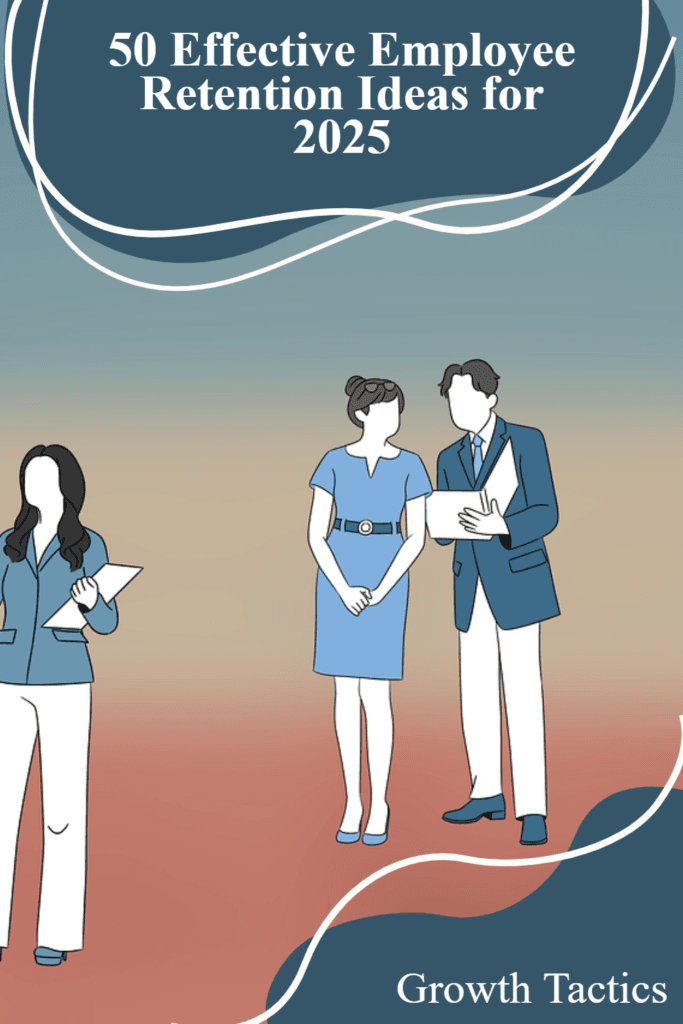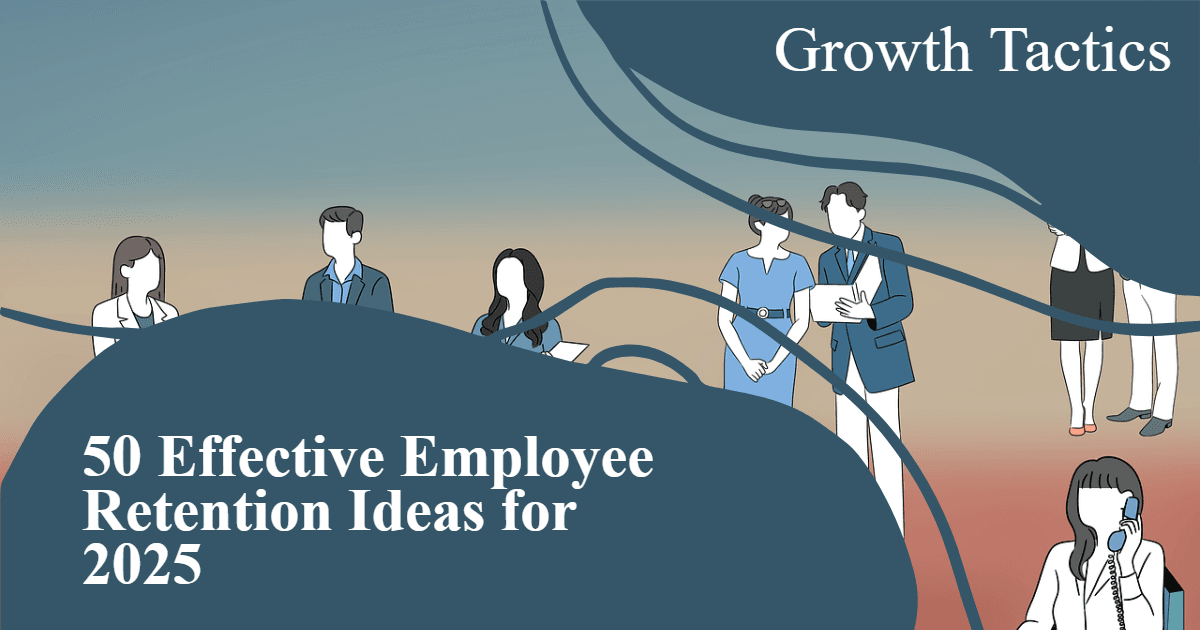Keeping valuable employees is crucial for any organization’s success. In 2025, the landscape of employee retention will require innovative and thoughtful strategies more than ever.
As leaders, we must understand that retaining great talent is more than just a checkbox on our to-do list. It demands a purposeful approach that respects each individual’s unique contributions.
This article will provide 50 effective employee retention ideas, focusing on practical solutions that value personal growth and problem-solving.
Jump To Section
Why Do Employees Leave and What’s the Impact on Organizations?
Employees might decide to leave their jobs for assorted, sometimes nuanced, reasons, but some recurring motivations include:
- Limited opportunities for career advancement.
- An unsatisfactory work environment or company culture.
- A sense of being underappreciated or overlooked.
- Insufficient compensation and benefits.
- A strained relationship with management.
The repercussions of employee turnover are far-reaching for an organization. Beyond the direct costs of recruiting and onboarding new staff, there are indirect effects such as the decline in productivity owing to unfilled roles and the additional workload for remaining employees. Moreover, employee morale can suffer as team members see their colleagues leave, potentially leading to further disengagement.
The Impact of Employee Retention on Business
Organizations often underestimate the real cost of high turnover. On the surface, it might seem simply linked to recruitment-related expenses like advertising job postings, running interviews, and onboarding new employees. However, the actual cost goes much further. Major components that add to the turnover cost include:
- Lost productivity: When an employee leaves, their tasks might be temporarily shifted to other employees, leading to overwork and stress. It’s also a given that the new hire will need some time to become fully productive.
- Training and development costs: It’s an investment to train new hires to the level of their predecessors. This involves both the hard costs of training programs and the time cost of trainers.
- Cultural impact: High turnover rates can also breed uncertainty in the remaining employees, inadvertently leading to lower morale, reduced engagement, and lessened productivity.
Benefits of Improved Employee Retention Rate
Conversely, a high employee retention rate brings along with it a raft of benefits:
- Reduced costs: It’s far less costly to retain existing employees than to recruit new ones.
- Preserved knowledge: Long-term employees hold crucial knowledge collected over the years, playing an integral role in making informed decisions.
- Continuity: Employee retention brings stability, ensuring that projects continue running smoothly.
Top 50 Employee Retention Ideas
Managing employee retention is essential for building a strong and committed team. By focusing on the unique needs and aspirations of your employees, you can create a supportive and engaging workplace. Here are 50 strategies that can help you retain your most valuable assets:
1. Offer Competitive Salaries and Benefits
You’ll attract and keep the best talent by offering competitive pay and comprehensive benefits packages. Think about industry standards, cost of living, and employee experience. Go beyond monetary rewards. Include health care, paid time off, flexible work hours, and performance-based bonuses.
2. Provide Opportunities for Professional Growth
People want to grow both personally and professionally. Provide them with training programs, workshops, mentorship, and clear career paths. Encourage them to broaden their skills, take on new responsibilities, and join interdepartmental projects.
3. Establish a Culture of Trust and Open Communication
Employees should feel safe to express their thoughts, ideas, and concerns. Cultivate transparency and trust. Encourage feedback and open dialogue through town hall meetings, one-on-one check-ins, and employee-suggestion programs.
4. Recognize and Reward Achievements
Show appreciation for hard work with recognition and rewards. Options include employee-of-the-month awards, formal or informal recognition, and company-wide announcements. Incentives could be bonuses, promotions, or non-monetary rewards like additional time off.
5. Focus on Satisfaction Through Regular Feedback
Use pulse surveys, suggestion boxes, and annual reviews to gauge employee satisfaction. Address pressing concerns and make data-driven decisions. Show employees that their opinions matter.
6. Implement Comprehensive Wellness Programs
Wellness programs for physical and mental health can boost satisfaction and engagement. Offer gym memberships, yoga classes, mental health resources, or healthy snacks. Show you care about your workforce’s well-being.
7. Offer Flexible Work Schedules and Remote Options
Flexibility in work schedules can boost morale and productivity. Allow part-time work or remote arrangements. This helps employees balance personal and professional demands.
8. Encourage Work-Life Balance
Lead by example. Encourage employees to take breaks, use their vacation time, and disconnect from work. Managers should demonstrate a healthy work-life balance.
9. Create Opportunities for Mentorship
Mentorship programs help employees personalize learning and development. They gain insights from experienced professionals and build relationships within the organization.
10. Promote Diversity and Inclusion
Foster a diverse and inclusive workplace. Value and respect all employees, regardless of their background. Provide diversity and inclusion training and hire from a diverse talent pool.
11. Provide Continuous Learning Programs
Offer workshops, online courses, or in-house training. By focusing on continuous learning, you strengthen your talent base and morale.
12. Prioritize Employee Safety and Well-Being
Ensure physical and emotional well-being with clear health and safety guidelines. Offer resources for mental health support.
13. Foster a Collaborative Work Environment
Encourage teamwork to boost productivity and morale. Use platforms and technologies that facilitate collaboration.
14. Offer Perks that Cater to Individual Interests
Tailor perks to the interests and lifestyles of your employees. Options might include discounted tickets to events, tech gadgets, or a pet-friendly office.
15. Encourage Team-Building Exercises
Host team-building events to improve communication and collaboration. These could be team lunches, parties, or offsite activities.
16. Maintain Transparent Communication
Keep employees informed about company goals and expectations. Regularly share updates and maintain clear communication.
17. Reinforce Company Values and Mission
Lead by example. Make sure all decisions and actions align with the company’s core values and mission.
18. Cultivate a Strong Leadership Team
Invest in leadership development. Strong leaders inspire and support their teams, enhancing engagement and retention.
19. Provide Ample Support for New Hires
Proper onboarding is key. Focus on job training, mentorship, and regular check-ins to help new hires feel welcomed and equipped.
20. Implement Stay and Exit Interviews
Conduct stay interviews to understand what engages employees. Use exit interviews to gain insights into why employees leave and improve from feedback.
21. Create Clear Career Paths
Offer detailed career progression plans. Discuss aspirations and guide employees on how to achieve their goals within the organization.
22. Offer Regular Performance Reviews
Regular reviews help employees understand their strengths and areas for improvement. Combine feedback with opportunities for growth to motivate employees.
23. Encourage Ownership of Work
Instill a sense of responsibility and initiative by encouraging employees to take ownership of their tasks.
24. Develop Employee Resource Groups
Create groups for shared interests. They reinforce a sense of belonging and community.
25. Support Internal Mobility
Allow employees to switch roles or departments. This broadens their skill set and keeps work experiences varied.
26. Provide Ongoing Training Programs
Continuous training helps employees stay updated. It benefits them professionally and boosts organizational strength.
27. Invest in Communication Tools
Use tools that promote effective communication. This encourages open dialogue and transparency.
28. Offer Tuition Reimbursement
Support further education. This investment encourages employees to upskill and stay long-term.
29. Establish Referral Programs
Referral programs can attract quality talent and boost morale.
30. Practice Fair Performance Evaluations
Transparent performance assessments foster trust and promote a culture of fairness.
31. Encourage Volunteer Opportunities
Offer opportunities for community service. This builds a positive company image and fosters a culture of empathy.
32. Customize Benefits Plans
Recognize that employees have unique needs. Offer flexible benefits packages that employees can customize.
33. Encourage Open-Door Policies
An open-door policy promotes open communication and feedback.
34. Offer Assistance Programs
Provide resources for mental health, stress management, and personal issues.
35. Recognize Milestones
Celebrate employee milestones and anniversaries to boost morale and loyalty.
36. Foster Continuous Improvement
Encourage employees to continually improve their skills. Provide resources for professional and personal development.
37. Encourage Growth Opportunities
Empower employees to explore growth opportunities within the organization.
38. Support Personal Aspirations
Show interest in employees’ hobbies and pursuits outside of work. Encourage work-life balance.
39. Create a Welcoming Environment
Maintain a positive office atmosphere with initiatives like casual Fridays or office decorations.
40. Maintain Mission Alignment
Regularly remind employees of the company’s purpose. Ensure alignment with these goals.
41. Implement Burnout Reduction Strategies
Encourage work-life balance and manage workloads to avoid excessive stress and burnout.
42. Hold Regular Town Hall Meetings
Use town hall meetings for updates and discussions. Promote transparency and inclusivity.
43. Offer Concierge Services
Provide perks like childcare, dry-cleaning, or personal errand assistance. This reduces stress and improves work-life balance.
44. Invest in Health Initiatives
Encourage physical health with gym memberships and wellness classes.
45. Address Workplace Bullying
Create a respectful environment. Address bullying or harassment promptly and encourage anonymous reporting.
46. Encourage Regular Breaks
Promote breaks and vacations to avoid burnout and sustain high performance.
47. Maintain Transparent Payroll Systems
Ensure timely and accurate compensation with transparent payroll details. This strengthens trust.
48. Establish Bonus Structures
Reward hard work with performance-based bonuses to motivate excellence.
49. Encourage Decision-Making Contributions
Allow employees to participate in decision-making processes. This instills a sense of ownership and engagement.
50. Regularly Review Retention Strategies
Keep retention strategies relevant by reviewing them based on feedback and trends. Adjust as necessary for continuous improvement.
By practicing these strategies, you create a work environment where employees feel valued and motivated, leading to higher retention and overall satisfaction.
Conclusion
Maintaining a strong, dedicated workforce is a key challenge faced by organizations in a dynamic business environment. As we approach 2025, the strategies mentioned above are crucial for effectively retaining valuable employees.
The importance of regular reviews, updates, and consistent improvements of the retention strategies cannot be overstated. The heart of these strategies is essentially respecting each employee’s needs and aspirations while equipping them to contribute their best to the organization.
As the business landscape and employment trends continue to evolve, organizations that master the art of employee retention can turn their workforce into a competitive advantage.


